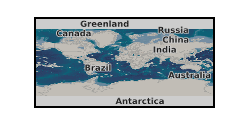Neodymium isotopes
Type of resources
Topics
Keywords
Contact for the resource
Provided by
Years
Formats
Representation types
Update frequencies
-

Neodymium (Nd) isotope data measured from IODP Site U1556 comprises of detailed sample information including 3 depth scales, the normalised 143/144 Nd ratio, the eNd(0) and eNd (t) values for each sample, plus the associated internal errors for normalised 143/144 Nd ratio, the eNd(0). Rare Earth Element (REE) data measured from IODP Site U1556 comprises of detailed sample information including 3 depth scales, mass of fish debris dissolved for each sample, the concentration of Phosphorous (P) and Calcium (Ca) in ppm, and the concentration of REEs in ppb. Additionally, the concentration of REEs has been normalised to the Post-Archean Australian Shale (PAAS) using values from Pourmand et al. 2012 have been included. Ce anomalies have been calculated using 2 similar methods, plus other REE parameters: LREE, MREE, HREE, MREE*, HREE/LREE, and MREE/MREE*. Percentage Calcium Carbonate (%CaCO3) data from IODP Sites U1557 and U1558 including detailed sample information including 3 depth scales where possible, and weight percentage CaCO3 data.
-

The file contains the validation data on certified reference material for Nd isotope measurement, the LA-MC-ICP-MS composite Pb isotope ratios and Nd isotope time series for Tropic Seamount, north-east Atlantic Ocean. The dataset spans a deposition history covering the last 75 Ma. The record was obtained by analysis of hydrogenetic ferromanganese crust samples recovered during the 2016 JC142 expedition of the MarineE-Tech project.
-

Neodymium (Nd) isotope data measured from fossil fish debris and sediment leaches collected from IODP Sites U1512, U1513, U1514 and U1516.
-

A worldwide compilation of 645 analyses of Sm and Nd concentrations, and Nd isotopes, in fine-grained continental sedimentary rocks with a range of deposition ages. These data were used in Dhuime et al. (2017, Sedimentary Geology 357, 16-32) to calculate the variation in the Nd model age of fine-grained continental sediments as a function of their age of deposition.
-

We collected major element, trace element and Nd isotopes of cumulate plagioclase and clinopyroxene in lower crustal gabbros from Hess Deep oceanic crust (~2°15'N, 101°30'W) to investigate the Nd isotopic heterogeneity of melts delivered to a complete section of Hess Deep oceanic crust, accreted at the fast-spreading (133 mm/yr) East Pacific Rise (EPR). These data are presented in Cooper et al. (2025) (https://doi.org/10.1130/G52872.1). Elemental maps of 58 samples were initially obtained prior to selecting a subset of 25 samples for in-situ microanalysis. We targeted the Nd isotope record of cumulate plagioclase and clinopyroxene from lower crustal gabbro samples, representing early crystallisation products of melts delivered to the crust. These samples were collected in several expeditions: Ocean Drilling Program (ODP) Leg 147; RSS James Cook cruise JC21; Integrated Ocean Drilling Program (IODP) Expedition 345 (Site U). Combined, these studies provide the most complete composite section of fast-spreading EPR crust to date (stratigraphic depth of 4350 m to 25 m). In our study, we selected 25 samples for in situ Nd isotope microanalysis, covering the range of mineralogy and textural diversity, and over the full stratigraphic depth. For a comparison to local MORB compositions, we selected a set of 13 upper-crustal sheeted dikes collected on the RSS James Cook cruise JC21. Our data reveal that the mantle is heterogeneous at the scale of melt extraction, and the crystal record from the lower crust shows greater 143Nd/144Nd heterogeneity than the overlying MORB. Hence, Pacific MORBs do not reflect the full heterogeneity of their mantle source, and some aggregation of melts occurs within the crust. Data was collected between 2020 and 2023 by George Cooper, Johan Lissenberg and Max Jansen at Cardiff University, UK, as part of NERC Grant NE/T000317/1:HiDe: A Highly Heterogeneous Depleted Upper Mantle? Mineral isotopic analyses were performed on a Thermo Scientific TRITON Plus at the Vrije Universiteit in Amsterdam. The long-term average and reproducibility (2019–2022) for the JNdi-1 standard is 0.512094 ± 0.000011 2 SD (standard deviation; n = 28) with 1011Ω resistors (used for clinopyroxene) and 0.512105 ± 0.000044 2 SD (n = 45) with four 1013Ω resistors (used for plagioclase). Full methodology can be found within the supplemental Material of Cooper et al. (2025) at https://doi.org/10.1130/GEOL.S.28485770 The DOI is a supplement to https://doi.org/10.1130/G52872.1 Methodology: https://gsapubs.figshare.com/articles/journal_contribution/Supplemental_Material_Crustal_versus_mantle-level_aggregation_of_heterogeneous_melts_at_mid-ocean_ridges/28485770?file=52665137
-

This dataset includes the (stable) oxygen and carbon isotopic composition of benthic foraminifer tests (n= 686) and the (radiogenic) isotopic composition of the terrigenous fraction of marine sediments (n= 75), all sampled from Eocene to Oligocene-aged sediments recovered at Ocean Drilling Program (ODP) Site 689 and 690 (Maud Rise, Southern Ocean)
 NERC Data Catalogue Service
NERC Data Catalogue Service